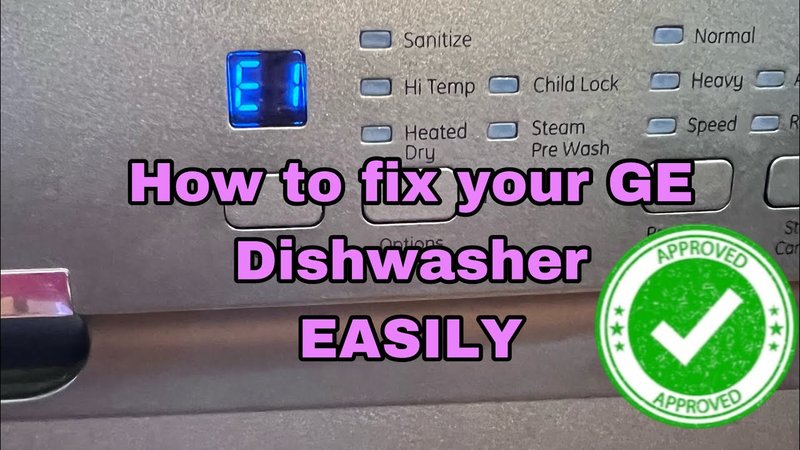
In simple terms, the E1 error code on a GE dishwasher is a signal that the machine’s drainage system isn’t working as it should. Think of it like water being stuck in a sink because of a blocked drain. Just as water can’t exit through the pipes, your dishwasher isn’t able to expel the used water, and it’s raising a flag to get your attention. It’s essential to tackle the issue promptly, not only to get your dishwasher back on track but also to prevent any potential damage that lingering water might cause.
Understanding the E1 Error Code
You might be wondering, what’s so complicated about a bit of drainage? Well, dishwashers are intricate machines, combining various components that must work in harmony for a smooth operation. The E1 error code is generally associated with a draining issue. The root cause could be a variety of things, from a simple kink in the hose to a more complicated problem inside the drainage pump. Picture it like trying to sip through a straw that’s pinched — water can’t flow properly, leaving you frustrated and the dishwasher half-done.
The E1 code acts like your dishwasher’s SOS signal. It relies on a sensor to determine if water isn’t draining out as it should. If the water level remains too high or doesn’t decrease within a set time, it signals a problem. Sometimes the issue is straightforward, like a piece of bone or a utensil accidentally stuck in the bottom filter. Other times, it might be a matter of unclogging the drain hose or checking the garbage disposal connection in your sink, especially if it’s newly installed or hasn’t been used much.
So, what’s your next move? Before diving into the depths of appliance repair, start by inspecting the obvious culprits. Open the dishwasher, remove the bottom rack, and check for any food debris around the drain area. Ensure that the drain hose is not kinked or blocked and that it’s connected securely. If you’re comfortable, you might detach the hose from the sink’s garbage disposal (make sure to turn off the electricity to the dishwasher first!) and give it a good cleanout. Often, these initial checks can resolve the error without much hassle.
Common Causes of Error Code E1
Now, let’s dive a little deeper into what could be causing this pesky error to surface. One common cause could be a clogged kitchen sink drain. Just like any pipe around your home, these drains can get clogged over time with food scraps, soap, and grease. Since the dishwasher often shares the same drain as your kitchen sink, an obstruction there can cause water to backflow into the machine, triggering the E1 error code. It’s like trying to force a river through a narrow, blocked alley — it just doesn’t go anywhere fast!
Another possible cause is related to the garbage disposal. In many modern kitchen setups, dishwashers are plumbed to run their drainage water through the disposal unit. If this unit is clogged or hasn’t been cleared recently, it can prevent water from leaving the dishwasher. Imagine trying to force more water into a bottle that’s already full — nowhere for it to go but back.
Finally, the problem might lie with the dishwasher’s own internal filter. It’s there to capture food particles and prevent them from clogging the plumbing. However, if it’s not cleaned regularly, it can become overwhelmed and stop working properly. A good analogy would be trying to vacuum a floor with a clogged filter — not much dirt gets picked up! Cleaning the filter is typically a simple process that involves removing it, rinsing with warm, soapy water, and replacing it. Doing this regularly can prevent the E1 code from appearing in the first place.
Resolving and Preventing Error Code E1
So, you’ve identified the rude interruption that the E1 error code represents, but how do you go about fixing it once and for all? Begin by performing a manual drain. This involves manually removing water from the dishwasher using a sponge or towel — something like bailing water from a boat. This step can often reset the error code, allowing you to run another cycle to determine if the issue persists.
If the problem still continues, you may need to perform a more thorough check of the dishwasher’s parts. Ensure all hoses are clear by disconnecting them and running water through them in the sink. For those who are a bit handier, unscrewing the dishwasher’s lower panel and inspecting the drainage pump could be beneficial. Listening for unusual sounds when the pump operates can also indicate whether it’s malfunctioning.
Preventing future occurrences of the E1 error code includes regular maintenance. Routinely clear out any food remnants left in the dishwasher, and make it a habit to clean the filter monthly. It’s akin to changing your car’s oil — regular upkeep goes a long way. Also, using the dishwasher regularly helps keep the motors and pumps from seizing up, so don’t let it sit idle for too long.
In summary, the E1 error code on a GE dishwasher is a manageable issue, often solved with some basic checks and routine maintenance. By understanding its causes and keeping up with regular care, you can keep your dishwasher in tip-top shape and avoid the disruption of a cycle gone wrong. So next time you hear that beep and see E1, you’ll know exactly what to do!